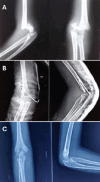A Prospective Analysis of Functional Outcome of Pediatric Supracondylar Humerus Fracture Treated with Closed Reduction and Percutaneous Pinning
- PMID: 40520729
- PMCID: PMC12159628
- DOI: 10.13107/jocr.2025.v15.i06.5738
A Prospective Analysis of Functional Outcome of Pediatric Supracondylar Humerus Fracture Treated with Closed Reduction and Percutaneous Pinning
Abstract
Introduction: Supracondylar humerus fractures are the most common elbow injuries in children, accounting for approximately 60% of all pediatric elbow fractures, primarily occurring in the first decade of life. These fractures are often associated with complications such as compartment syndrome, neurovascular injury, Volkmann's ischemic contracture, and malunion. The most common complication is cubitus varus deformity. The preferred pinning techniques include either a crossed pin construct or two lateral pins. Among various treatment approaches, closed reduction with percutaneous K-wire fixation has been found to be the most effective, with minimal complications. This study aims to assess the functional and radiological outcomes of pediatric displaced supracondylar humerus fractures managed with closed reduction and percutaneous K-wire fixation.
Materials and methods: 35 consecutive patients meeting the study's inclusion and exclusion criteria were enrolled. Data are collected and analyzed using Microsoft Excel for statistical calculations.
Results: In this study, 25 children (62%) sustained the fracture within the first decade of life. Males showed a higher incidence than females. The Mayo elbow scores recorded at 6 months was 96.01 ± 2.80. Pin tract infections were observed in 10 patients, while 3 cases presented with cubitus rectus. Clinical outcomes, evaluated using Flynn's criteria, showed fair outcome in 1 case, good outcomes in 3 cases, and excellent outcomes in 31 cases.
Conclusion: Percutaneous pinning after closed reduction, whether using a crossed configuration or lateral pinning remains the preferred treatment for supracondylar fracture of the humerus in pediatric patients. When performed with the proper technique, both configurations yield successful outcomes. This approach is a safe, economical, and least invasive option with low morbidity.
Keywords: Baumann’s angle; Mayo elbow score; Supracondylar humerus fracture; pediatric population.
Copyright: © Indian Orthopaedic Research Group.
Conflict of interest statement
Conflict of Interest: Nil
Figures




Similar articles
-
Outcome Analysis of Lateral Pinning for Displaced Supracondylar Fractures in Children Using Three Kirschner Wires in Parallel and Divergent Configuration.Indian J Orthop. 2018 Sep-Oct;52(5):554-560. doi: 10.4103/ortho.IJOrtho_462_17. Indian J Orthop. 2018. PMID: 30237614 Free PMC article.
-
Closed reduction and percutaneous pinning of displaced supracondylar fractures of humerus in children with delayed presentation.Chin J Traumatol. 2011 Feb 1;14(1):14-9. Chin J Traumatol. 2011. PMID: 21276362
-
Management of pediatric distal humerus metaphyseal-diaphyseal junction fracture: A systematic review and meta-analysis.J Child Orthop. 2024 Jun 22;18(4):421-431. doi: 10.1177/18632521241262169. eCollection 2024 Aug. J Child Orthop. 2024. PMID: 39100985 Free PMC article. Review.
-
Prospective Study of Functional and Radiological Outcome after Operative Management of Supracondylar Fracture Humerus in Children.J Orthop Case Rep. 2025 Mar;15(3):257-264. doi: 10.13107/jocr.2025.v15.i03.5406. J Orthop Case Rep. 2025. PMID: 40092266 Free PMC article.
-
Operative treatment of supracondylar fractures of the humerus in children: the Cincinnati experience.Acta Orthop Belg. 1996;62 Suppl 1:41-50. Acta Orthop Belg. 1996. PMID: 9084559 Review.
References
-
- MacEwen GD. Tachdjian s Pediatric Orthopaedics. 3rd ed. Vol. 1, 2, 3. Netherlands: Elsevier Health Sciences; 2002. p. 1104.
-
- Kocher MS, Kasser JR, Waters PM, Bae D, Snyder BD, Hresko MT, et al. Lateral entry compared with medial and lateral entry pin fixation for completely displaced supracondylar humeral fractures in children. A randomized clinical trial. J Bone Joint Surg Ser A. 2007;89:706–12. - PubMed
-
- Ramachandran M, Skaggs DL, Crawford HA, Eastwood DM, Lalonde FD, Vitale MG, et al. Delaying treatment of supracondylar fractures in children:Has the pendulum swung too far? J Bone Joint Surg Br. 2008;90:1228–33. - PubMed
-
- Cheng JC, Lam TP, Maffulli N. Epidemiological features of supracondylar fractures of the humerus in Chinese children. J Pediatr Orthop Part B. 2001;10:63–7. - PubMed
-
- Brauer CA, Lee BM, Bae DS, Waters PM, Kocher MS. A systematic review of medial and lateral entry pinning versus lateral entry pinning for supracondylar fractures of the humerus. J Pediatr Orthop B. 2007;27:181–6. - PubMed
LinkOut - more resources
Full Text Sources
